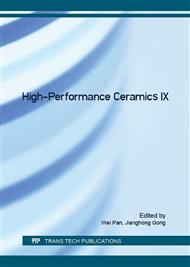p.235
p.239
p.243
p.248
p.253
p.257
p.262
p.267
p.271
Densification Behavior and Dielectric Properties of CaO-B2O3-SiO2 System Glass-Ceramics Containing ZrO2
Abstract:
CaO–B2O3–SiO2 (CBS) glass-ceramics containing ZrO2 were prepared by conventional melting and heat treated crystallization method. The effects of ZrO2 on the crystallization behavior, sintering characterization and dielectric properties of the glass-ceramics were analyzed respectively. The results indicated that ZrO2 addition can improve the crystallization and densification of CBS glass-ceramics. The major crystallized phase of sample with≥7wt% ZrO2 was cyclowollastonite (α-CaSiO3).It is found that the optimal sintering condition for the glass-ceramics is 770 oC for 30min. CBS glass ceramics sample with 7wt% ZrO2 shows the best sintering characterization and dielectric properties (ρ= 2.71g/cm3, εr ≈8.8,tan δ=2.36×10-3 at 1 MHz), which is supposed to be suitable for LTCC application.
Info:
Periodical:
Pages:
253-256
Citation:
Online since:
July 2016
Authors:
Keywords:
Price:
Сopyright:
© 2016 Trans Tech Publications Ltd. All Rights Reserved
Share:
Citation:


